lock MINI Hardtop 2 Door 2005 Owner's Guide
[x] Cancel search | Manufacturer: MINI, Model Year: 2005, Model line: Hardtop 2 Door, Model: MINI Hardtop 2 Door 2005Pages: 165, PDF Size: 2.32 MB
Page 42 of 165
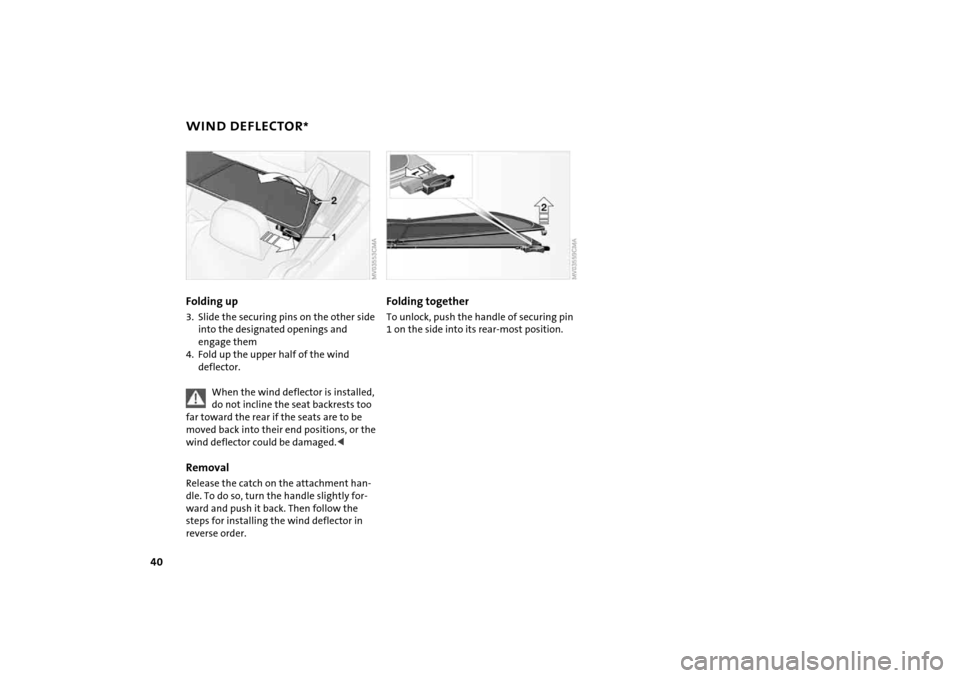
40
WIND DEFLECTOR
*
Folding up3. Slide the securing pins on the other side
into the designated openings and
engage them4. Fold up the upper half of the wind
deflector.
When the wind deflector is installed, do not incline the seat backrests too
far toward the rear if the seats are to be
moved back into their end positions, or the
wind deflector could be damaged.<
RemovalRelease the catch on the attachment han
-
dle. To do so, turn the handle slightly for
-
ward and push it back. Then follow the
steps for installing the wind deflector in
reverse order.
Folding togetherTo unlock, push the handle of securing pin
1 on the side into its rear-most position.
Page 43 of 165
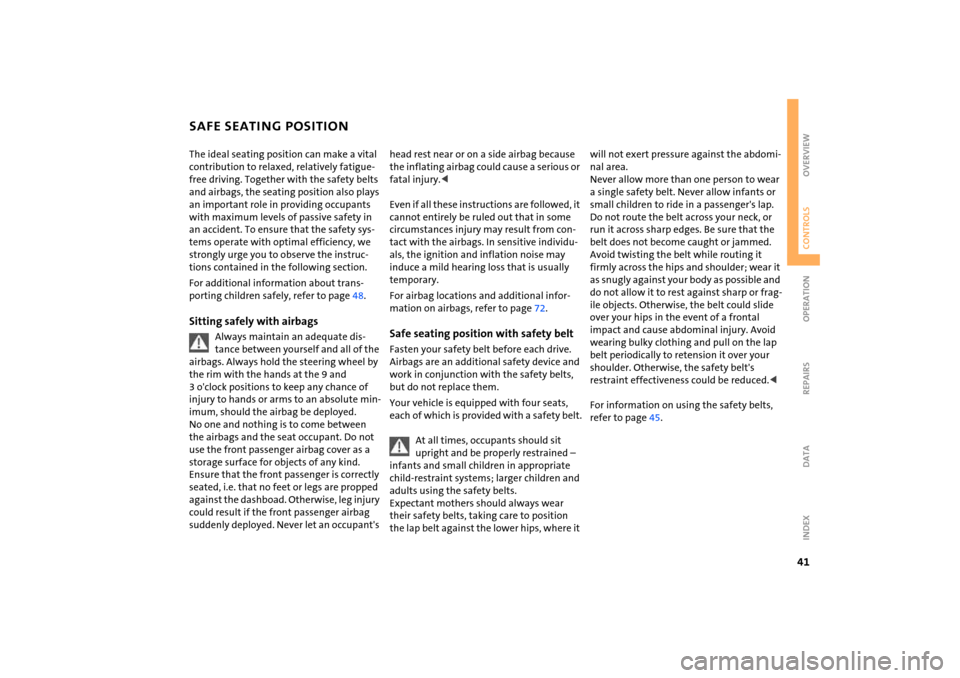
41
OVERVIEW REPAIRS OPERATIONCONTROLS DATA INDEX
SAFE SEATING POSITIONThe ideal seating position can make a vital
contribution to relaxed, relatively fatigue-
free driving. Together with the safety belts
and airbags, the seating position also plays
an important role in providing occupants
with maximum levels of passive safety in
an accident. To ensure that the safety sys
-
tems operate with optimal efficiency, we
strongly urge you to observe the instruc
-
tions contained in the following section.For additional information about trans
-
porting children safely, refer to page
48.
Sitting safely with airbags
Always maintain an adequate dis
-
tance between yourself and all of the
airbags. Always hold the steering wheel by
the rim with the hands at the 9 and
3
o'clock positions to keep any chance of
injury to hands or arms to an absolute min
-
imum, should the airbag be deployed.
No one and nothing is to come between
the airbags and the seat occupant. Do not
use the front passenger airbag cover as a
storage surface for objects of any kind.
Ensure that the front passenger is correctly
seated, i.e. that no feet or legs are propped
against the dashboad. Otherwise, leg injury
could result if the front passenger airbag
suddenly deployed. Never let an occupant's
head rest near or on a side airbag because
the inflating airbag could cause a serious or
fatal injury.
circumstances injury may result from con
-
tact with the airbags. In sensitive individu
-
als, the ignition and inflation noise may
induce a mild hearing loss that is usually
temporary. For airbag locations and additional infor
-
mation on airbags, refer to page
72.
Safe seating position with safety belt Fasten your safety belt before each drive.
Airbags are an additional safety device and
work in conjunction with the safety belts,
but do not replace them.Your vehicle is equipped with four seats,
each of which is provided with a safety belt.
At all times, occupants should sit upright and be properly restrained –
infants and small children in appropriate
child-restraint systems; larger children and
adults using the safety belts.
Expectant mothers should always wear
their safety belts, taking care to position
the lap belt against the lower hips, where it
will not exert pressure against the abdomi
-
nal area.
Never allow more than one person to wear
a single safety belt. Never allow infants or
small children to ride in a passenger's lap.
Do not route the belt across your neck, or
run it across sharp edges. Be sure that the
belt does not become caught or jammed.
Avoid twisting the belt while routing it
firmly across the hips and shoulder; wear it
as snugly against your body as possible and
do not allow it to rest against sharp or frag
-
ile objects. Otherwise, the belt could slide
over your hips in the event of a frontal
impact and cause abdominal injury. Avoid
wearing bulky clothing and pull on the lap
belt periodically to retension it over your
shoulder. Otherwise, the safety belt's
restraint effectiveness could be reduced.
45.
Page 45 of 165

43
OVERVIEW REPAIRS OPERATIONCONTROLS DATA INDEX
SEAT ADJUSTMENT
HEAD RESTRAINTS
Lumbar support* You can adjust the contour of the backrest
for additional support in the curvature of
your spine's lumbar region. The upper hips
and spinal column receive supplementary
support to help you maintain a relaxed,
upright posture. Turn the wheel.
The curvature is increased or decreased.
Backrest tilt 1. Pull up the lever at the inside of the seat2. Apply weight to or remove weight from
the backrest as required3. Release the lever so that the backrest
locks into place.
AdjustingTo raise: pull the head restraint upward.To lower: press the button and push the
head restraint downward.
You can reduce the risk of spinal injury and whiplash by adjusting the
head restraint to a height at which it is cen
-
tered roughly at ear level.
To avoid possible violation of traffic laws,
never retract the head restraints unless the
rear seats are empty. Always ensure that
the head restraints are raised before trans
-
porting passengers in the rear seat.<
Page 46 of 165
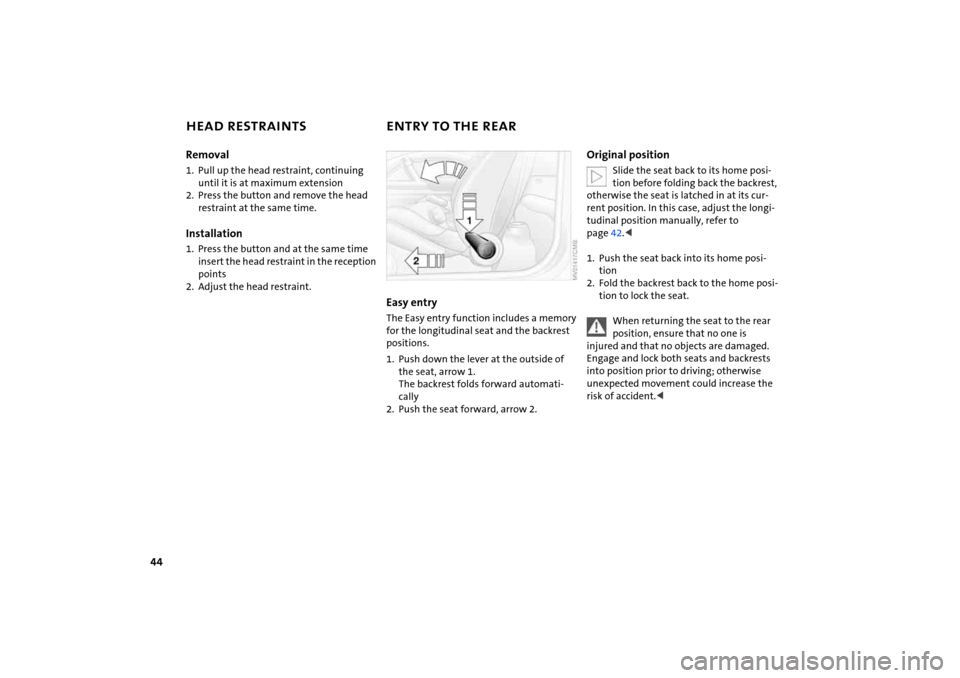
44
HEAD RESTRAINTS
ENTRY TO THE REAR
Removal1. Pull up the head restraint, continuing
until it is at maximum extension2. Press the button and remove the head
restraint at the same time.Installation1. Press the button and at the same time
insert the head restraint in the reception
points2. Adjust the head restraint.
Easy entryThe Easy entry function includes a memory
for the longitudinal seat and the backrest
positions.1.
Push down the lever at the outside of the seat, arrow 1.
The backrest folds forward automati
-
cally
2. Push the seat forward, arrow
2.
Original position
Slide the seat back to its home posi
-
tion before folding back the backrest,
otherwise the seat is latched in at its cur
-
rent position. In this case, adjust the longi
-
tudinal position manually, refer to
page
42.<
1. Push the seat back into its home posi
-
tion
2. Fold the backrest back to the home posi
-
tion to lock the seat.
When returning the seat to the rear position, ensure that no one is
injured and that no objects are damaged.
Engage and lock both seats and backrests
into position prior to driving; otherwise
unexpected movement could increase the
risk of accident.<
Page 47 of 165
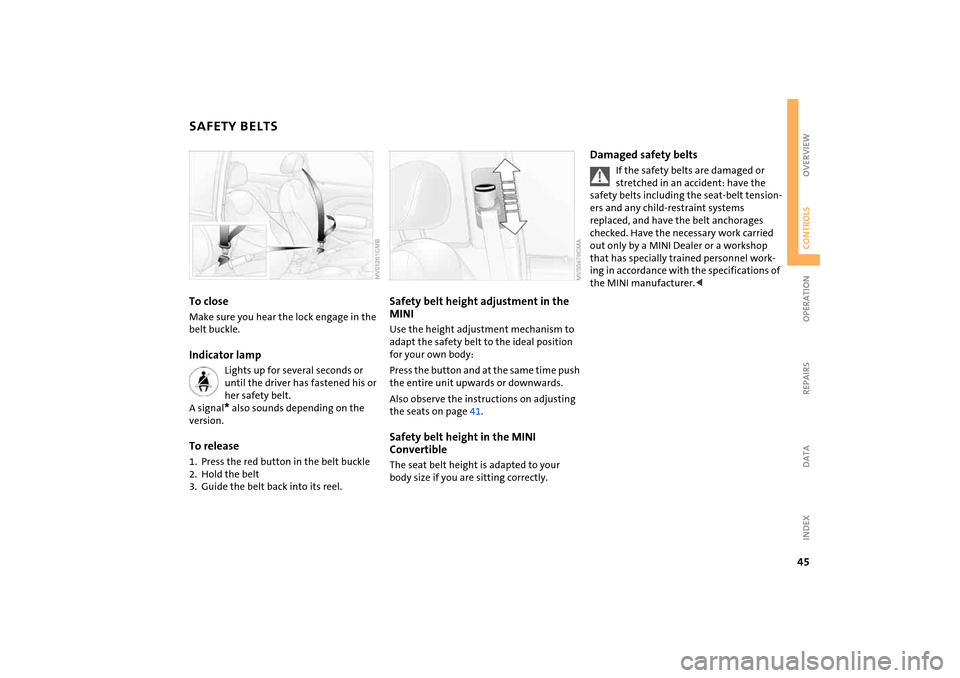
45
OVERVIEW REPAIRS OPERATIONCONTROLS DATA INDEX
SAFETY BELTS To closeMake sure you hear the lock engage in the
belt buckle.Indicator lamp
Lights up for several seconds or until the driver has fastened his or
her safety belt.
A signal
* also sounds depending on the
version.
To release1. Press the red button in the belt buckle2. Hold the belt3. Guide the belt back into its reel.
Safety belt height adjustment in the MINI Use the height adjustment mechanism to
adapt the safety belt to the ideal position
for your own body:Press the button and at the same time push
the entire unit upwards or downwards.Also observe the instructions on adjusting
the seats on page
41.
Safety belt height in the MINI
Convertible The seat belt height is adapted to your
body size if you are sitting correctly.
Damaged safety belts
If the safety belts are damaged or stretched in an accident: have the
safety belts including the seat-belt tension
-
ers and any child-restraint systems
replaced, and have the belt anchorages
checked. Have the necessary work carried
out only by a MINI Dealer or a workshop
that has specially trained personnel work
-
ing in accordance with the specifications of
the MINI manufacturer.<
Page 48 of 165
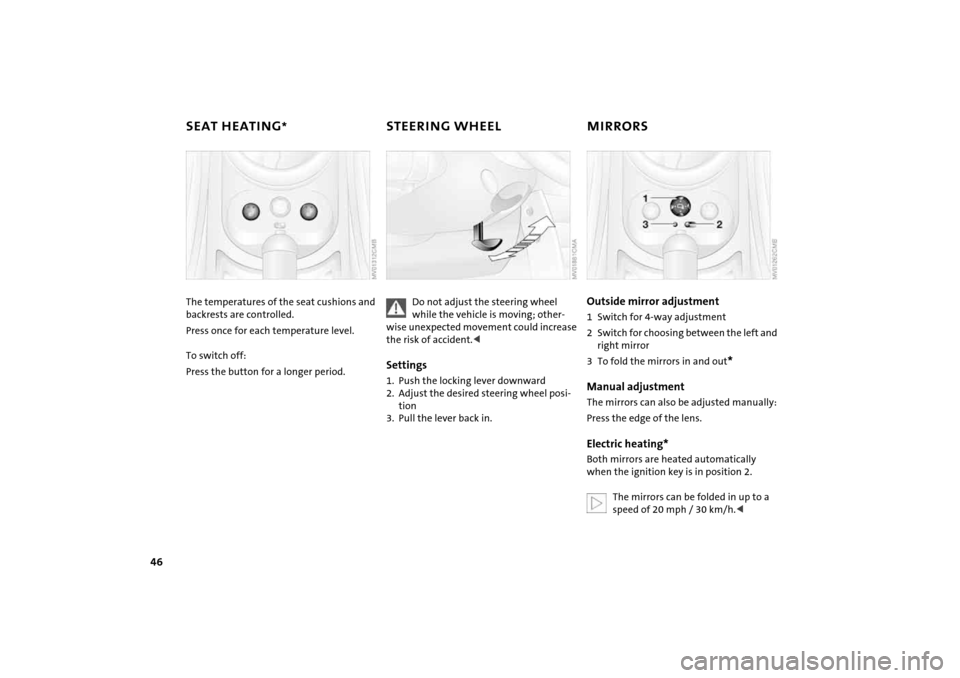
46
SEAT HEATING
*
STEERING WHEEL
MIRRORS
The temperatures of the seat cushions and backrests are controlled.Press once for each temperature level.To switch off:Press the button for a longer period.
Do not adjust the steering wheel while the vehicle is moving; other
-
wise unexpected movement could increase
the risk of accident.
tion
3. Pull the lever back in.
Outside mirror adjustment1 Switch for 4-way adjustment 2 Switch for choosing between the left and
right mirror 3 To fold the mirrors in and out
*
Manual adjustmentThe mirrors can also be adjusted manually: Press the edge of the lens.Electric heating* Both mirrors are heated automatically
when the ignition key is in position
2.
The mirrors can be folded in up to a speed of 20
mph
/ 30 km/h.<
Page 49 of 165

47
OVERVIEW REPAIRS OPERATIONCONTROLS DATA INDEX
MIRRORS
VEHICLE MEMORY
Interior rearview mirror To reduce glare from vehicles behind you
when you are driving at night:Turn the knob.Illuminated vanity mirror From ignition key position
1:
1. Fold down the sun visor2. Fold the cover panel upwards.Sun visorsCan be swung sideways.An additional sun visor is provided on the
driver's side to better protect the driver
from being blinded.
Interior mirror, automatic dimming* While the vehicle is being driven forward,
these mirrors dim light through an infi
-
nitely variable range depending on the
light's incidence. Two photocells in the
interior rearview mirror serve this purpose.
One is positioned on the underside of the
mirror frame, while the other is slightly off
-
set on the back of the mirror.In order for the photocells to work opti
-
mally, keep them clean and do not cover
the area between the interior rearview mir
-
ror and the windshield. Do not place stick
-
ers or toll tags on the windshield in front of
the mirror.
How the system functionsNo doubt you have often reflected on how
great it would be if you could configure
your vehicle's various adjustment settings
to meet your own personal requirements.
In developing this vehicle, the manufac
-
turer of the MINI has incorporated a num
-
ber of options which can be programmed
specifically for your vehicle. What the system can doYour MINI Dealer can provide you with
details on the capabilities of the Vehicle
Memory system.Examples for Vehicle Memory:>Automatic locking if none of the vehicle
doors are opened, refer to page
26
>Automatic locking after starting to drive,
refer to page
28
>Selective central locking system, refer to
pages
26, 27
>Convenience operation, refer to
pages
26, 27
>'Follow-me-home' lamps, refer to
page
57
>Daytime driving lamps, refer to page
58
>Speed-dependent windshield wipers,
refer to page
60
Page 51 of 165

49
OVERVIEW REPAIRS OPERATIONCONTROLS DATA INDEX
TRANSPORTING CHILDREN SAFELYInstalling child-restraint systemsBefore installing any child-restraint system
or child seat, read the following:
Always follow the manufacturer's instructions concerning installation
and use; otherwise the system's protective
function could be impaired. After an acci
-
dent, have all parts of the child-restraint
system and the affected safety belt system
inspected and/or replaced. Have the neces
-
sary work on your MINI carried out only by
a MINI Dealer or a workshop that has spe
-
cially trained personnel working in accor
-
dance with the specifications of the MINI
manufacturer.
tems are designed to be secured with a lap
belt or with the lap belt portion of a combi
-
nation lap/shoulder belt. Improperly or
inadequately installed restraint systems
can increase the risk of injury to children.
Always read and follow the instructions
that come with the system.
Child seat securityAll of the rear belt retractors and the front
passenger's safety belt can be locked for
mounting and securing child-restraint sys
-
tems.Information regarding this is located near
the buckle latch of each safety belt.
To lock the beltPull the entire length of the belt from the
belt retractor. Allow the reel to retract the
belt somewhat and engage the buckle,
then tighten the belt against the child-
restraint system.
The retraction mechanism is now locked. To unlock the beltRelease the buckle, remove the child-
restraint system and allow the belt retrac
-
tor to reel the belt completely in.
Page 53 of 165

51
OVERVIEW REPAIRS OPERATIONCONTROLS DATA INDEX
IGNITION LOCK
STARTING THE ENGINE
0 Steering locked
The key can be inserted or removed in this
position only.To lock the steering:1. Remove the key2. Turn the steering wheel slightly to the
left or right until the lock engages.A sound alarm goes off if the key remains in
the ignition after opening the driver's door.Interlock Vehicles with Continuously Variable auto
-
matic Transmission (CVT):
The ignition key cannot be turned to
position
0 and removed until the selector
lever is in position
P.
1 Steering unlocked
Individual electrical accessories are ready
for operation.You will find that it is often easier to turn
the ignition key from position
0 to
position
1 when you move the steering
wheel slightly to help disengage the lock.
2 Ignition switched on
All electrical accessories are ready for oper
-
ation.3 Starting the engine
Vehicles with manual transmission:
Step on the clutch when starting the
vehicle. A lockout prevents the engine from
starting if the clutch is not depressed.<
Do not allow the engine to run in enclosed spaces. Breathing the nox
-
ious exhaust gases can lead to uncon
-
sciousness and death. The exhaust gases
contain carbon monoxide, an odorless and
colorless, but highly toxic gas.
Do not leave the vehicle unattended with
the engine running. This is a safety hazard.
When driving, standing at idle, and parking
the vehicle, take care to avoid contact
between the hot exhaust system and flam
-
mable materials, e.g. hay, grass, leaves, etc.
Such contact could lead to a fire resulting in
serious personal injury and property dam
-
age.
vehicle at a standstill. Move off immedi
-
ately at a moderate engine speed.
Page 54 of 165
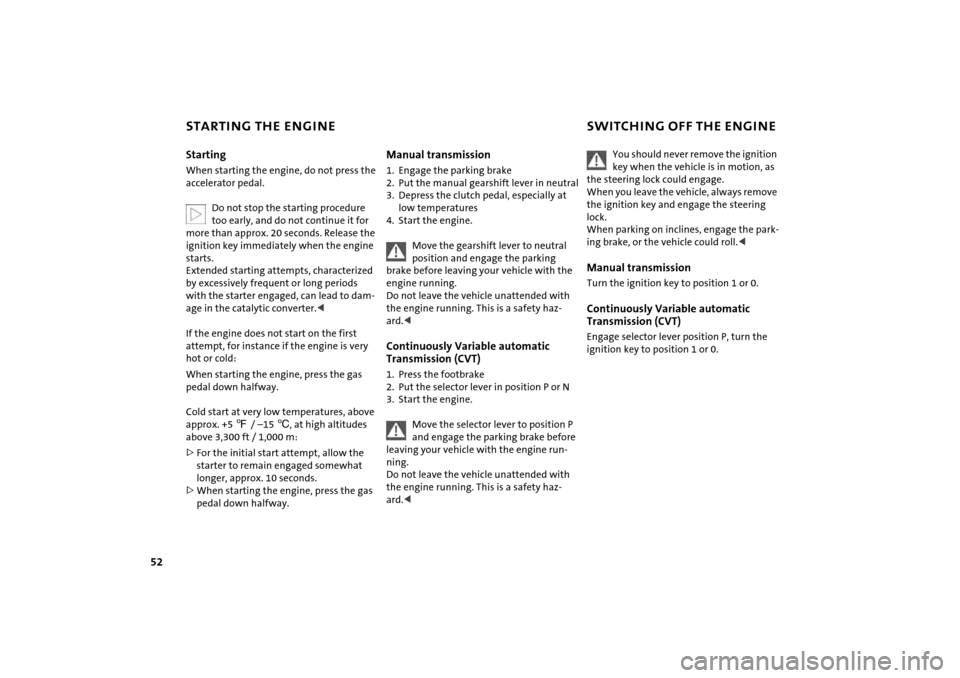
52
STARTING THE ENGINE
SWITCHING OFF THE ENGINE
StartingWhen starting the engine, do not press the
accelerator pedal.
Do not stop the starting procedure too early, and do not continue it for
more than approx. 20
seconds. Release the
ignition key immediately when the engine
starts.
Extended starting attempts, characterized
by excessively frequent or long periods
with the starter engaged, can lead to dam
-
age in the catalytic converter.
hot or cold:When starting the engine, press the gas
pedal down halfway.Cold start at very low temperatures, above
approx. +5
7
/ –15
6, at high altitudes
above 3,300
ft / 1,000 m:
>For the initial start attempt, allow the
starter to remain engaged somewhat
longer, approx. 10
seconds.
>When starting the engine, press the gas
pedal down halfway.
Manual transmission1. Engage the parking brake2. Put the manual gearshift lever in neutral3. Depress the clutch pedal, especially at
low temperatures4. Start the engine.
Move the gearshift lever to neutral position and engage the parking
brake before leaving your vehicle with the
engine running.
Do not leave the vehicle unattended with
the engine running. This is a safety haz
-
ard.
P or N
3. Start the engine.
Move the selector lever to position
P
and engage the parking brake before
leaving your vehicle with the engine run
-
ning.
Do not leave the vehicle unattended with
the engine running. This is a safety haz
-
ard.<
You should never remove the ignition key when the vehicle is in motion, as
the steering lock could engage.
When you leave the vehicle, always remove
the ignition key and engage the steering
lock.
When parking on inclines, engage the park
-
ing brake, or the vehicle could roll.
Continuously Variable automatic
Transmission (CVT)Engage selector lever position
P, turn the
ignition key to position
1 or 0.